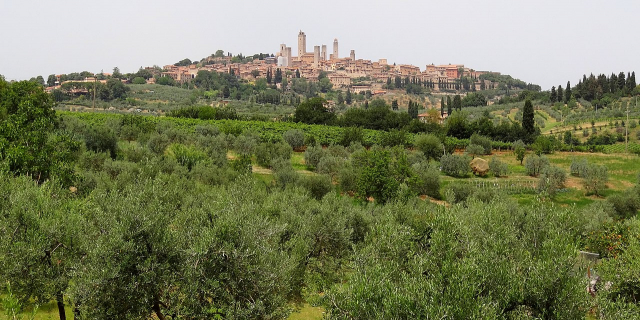Orvieto
Orvieto (Italian: [orˈvjɛːto]) is a city and comune in the Province of Terni, southwestern Umbria, Italy, situated on the flat summit of a large butte of volcanic tuff. The city rises dramatically above the almost-vertical faces of tuff cliffs that are completed by defensive walls built of the same stone.
The ancient city (urbs vetus in Latin, whence "Orvieto"), populated since Etruscan times, has usually been associated with Etruscan Velzna, but some modern scholars differ. Orvieto was certainly a major centre of Etruscan civilization; the archaeological museum (Museo Claudio Faina e Museo Civico) houses some of the Etruscan artifacts that have been recovered in the immediate area. A tomb in the Orvieto Cannicella necropolis bears the inscription mi aviles katacinas, "I am of Avile Katacina"; the tomb's occupant thus bore an Etruscan-Latin first name, Aulus, and a family name that is believed to be of Celtic origin (derived from "Catacos"). This interesting artifact might show the complexity of ethnic relations in ancient Italy, and how such relations could be peaceful.
Also in the area is the Golini Tomb, which was constructed in the fourth century BCE. Its wall paintings depict a funeral banquet, giving some insight into the real-life gatherings held after the deaths of aristocratic Etruscans. The pictures include scenes of servants preparing for the feast in various ways.[1]
Roman and post-Roman erasOrvieto was annexed by Rome in the third century BC. Because of its site on a high, steep bluff of tuff, a volcanic rock, the city was virtually impregnable. After the collapse of the Roman Empire its defensible site gained new importance: the episcopal seat was transferred from Bolsena, and the city was held by Goths and by Lombards before its self-governing commune was established in the tenth century, in which consuls governed under a feudal oath of fealty to the bishop. Orvieto's relationship to the papacy has been a close one; in the tenth century Pope Benedict VII visited the city of Orvieto with his nephew, Filippo Alberici, who later settled there and became Consul of the city-state in 1016. By the thirteenth century, three papal palaces had been built.
Middle AgesOrvieto, sitting on its impregnable rock controlling the road between Florence and Rome where it crossed the Chiana, was a large town: its population numbered about 30,000 at the end of the 13th century.[2] Its municipal institutions already recognized in a papal bull of 1157,[3] from 1201 Orvieto governed itself through a podestà, who was as often as not the bishop, however, acting in concert with a military governor, the "captain of the people". In the 13th century bitter feuds divided the city, which was at the apogée of its wealth but found itself often at odds with the papacy, even under interdict. Pope Urban IV stayed at Orvieto from 1262 to 1264.
The city became one of the major cultural centers of its time when Thomas Aquinas taught at the studium there. A small university (now part of the University of Perugia), had its origins in a studium generale that was granted to the city by Pope Gregory IX in 1236. After teaching in Orvieto, Aquinas was called to Rome in 1265 to serve as papal theologian to the newly elected Pope Clement IV, and as Regent master of the Santa Sabina studium provinciale, the forerunner of the Pontifical University of Saint Thomas Aquinas, Angelicum.
Papal ruleThe territory of Orvieto was under papal control long before it was officially added to the Papal States (various dates are quoted). It remained a papal possession until 1860, when it was annexed to unified Italy.


































Add new comment